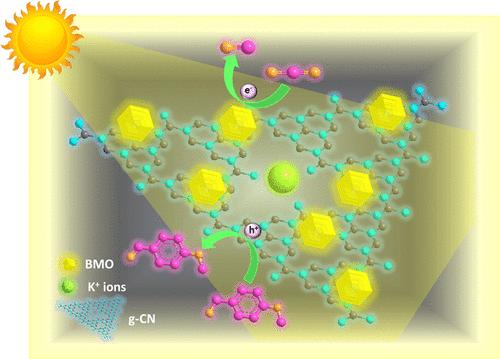太阳能驱动的低碳燃料和增值化学品:Bi2MoO6/K+插层氮化碳光催化剂在碳升级和生物质转化中的应用
IF 7.3
1区 化学
Q1 CHEMISTRY, MULTIDISCIPLINARY
引用次数: 0
摘要
光催化二氧化碳(CO2)减少与生物质基酒精转化的协同作用是一种可持续的战略,可以在精细化学品合成的同时保持碳中性循环。本文报道了一种异质结构的钾(K+)插层氮化碳(K- cn)与Bi2MoO6 (BMO)形成Z-scheme BMO/K- cn作为光催化剂。结果表明,在模拟太阳光照下,5BMO/K-CN异质结构的CO产率最高(21 mmol g-1h-1),生物质基对甲氧基苄基醇(p-MeOBA)在6 h内转化为相应的醛的速度为31%。在λ = 400 nm处CO产量的AQY估计为14.21%。通过x射线光电子能谱(XPS)测量、电子顺磁共振(EPR)研究和光致发光(PL)实验验证了Z-scheme的形成,证明了其具有更好的电荷分离和迁移能力,从而获得了卓越的光催化性能。此外,通过EPR实验对5BMO/K-CN的构效相关性进行了进一步的探讨。因此,目前的工作特点是利用插层氮化碳系统实现碳升级和生物质转化为太阳能燃料和精细化学品的可持续方法。本文章由计算机程序翻译,如有差异,请以英文原文为准。

Solar-Driven Low Carbon Fuel and Value-Added Chemicals: An Exemplification in Carbon Upscaling and Biomass Conversion via Bi2MoO6/K+ Intercalated Carbon Nitride Photocatalyst
Photocatalytic carbon dioxide (CO2) reduction in synergism with biomass-based alcohol conversion is a sustainable strategy to maintain a carbon-neutral cycle along with the synthesis of fine chemicals. Herein, we report a heterostructure of potassium (K+) intercalated carbon nitride (K-CN) with Bi2MoO6 (BMO) forming a Z-scheme BMO/K-CN as photocatalyst. We observed that the 5BMO/K-CN heterostructure achieves the highest CO production rate (21 mmol g–1h–1) along with biomass-based para-methoxybenzyl alcohol (p-MeOBA) conversion to the corresponding aldehyde by 31% in 6 h under simulated solar light. AQY for the CO production at λ = 400 nm was estimated as 14.21%. Z-scheme formation was verified by X-ray photoelectron spectroscopy (XPS) measurements, electron paramagnetic resonance (EPR) studies, and photoluminescence (PL) experiment leading to better charge separation and migration that resulted in remarkable photocatalytic performance. Further, more insights regarding structure–activity correlation of 5BMO/K-CN were explored through EPR experiments. Thus, the current work features a sustainable approach for carbon upscaling and biomass conversion into solar fuels and fine chemicals using the intercalated carbon nitride system.
求助全文
通过发布文献求助,成功后即可免费获取论文全文。
去求助
来源期刊

ACS Sustainable Chemistry & Engineering
CHEMISTRY, MULTIDISCIPLINARY-ENGINEERING, CHEMICAL
CiteScore
13.80
自引率
4.80%
发文量
1470
审稿时长
1.7 months
期刊介绍:
ACS Sustainable Chemistry & Engineering is a prestigious weekly peer-reviewed scientific journal published by the American Chemical Society. Dedicated to advancing the principles of green chemistry and green engineering, it covers a wide array of research topics including green chemistry, green engineering, biomass, alternative energy, and life cycle assessment.
The journal welcomes submissions in various formats, including Letters, Articles, Features, and Perspectives (Reviews), that address the challenges of sustainability in the chemical enterprise and contribute to the advancement of sustainable practices. Join us in shaping the future of sustainable chemistry and engineering.
 求助内容:
求助内容: 应助结果提醒方式:
应助结果提醒方式:


